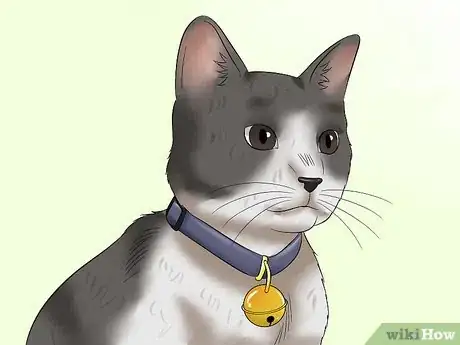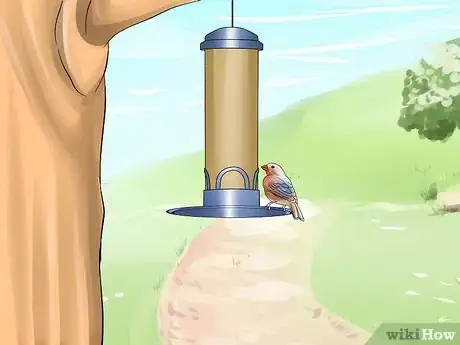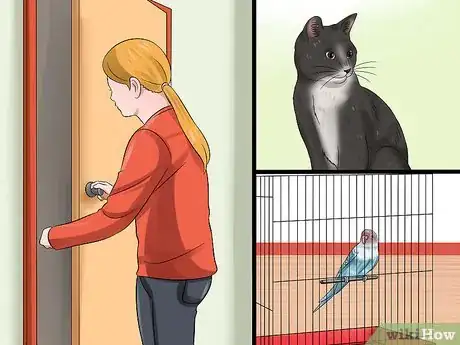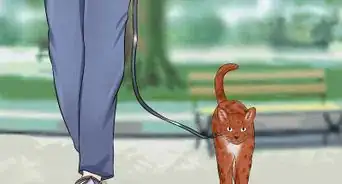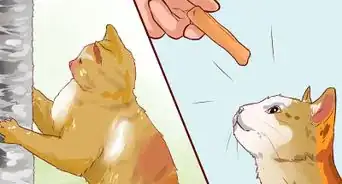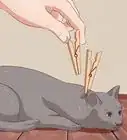This article was co-authored by Joey Lusvardi. Joey is a Cat Training & Behavior Expert and Owner of Class Act Cats based in Minneapolis, Minnesota. With five years of experience, Joey specializes in feline behavioral issues and customized treatment plans with the goal of integrating cats into their homes and families. Joey is a Certified Cat Behavior Consultant through the IAABC and a member of the Pet Professional Guild.
There are 19 references cited in this article, which can be found at the bottom of the page.
This article has been viewed 19,561 times.
Even though they are cute and cuddly, cats are natural hunters. Birds are some of their favorite prey. You cannot stop cats from being hunters, but you can do some things to protect the birds and alert them when your cat is coming. You can also deter your cat from going after them.
Steps
Stopping Your Cat
-
1Keep the cat inside. Keeping your cat inside permanently is the easiest solution to this problem. However, cats like to roam and may start focusing on other items like your shoes. Your cat must be trained to enjoy the indoors exclusively. Buy your cat some new toys and play with your cat to keep it entertained. Eventually, your cat will be content with staying inside all of the time.[1]
- If you can't keep your cat inside all day, have a curfew. Sunset, sunrise, and around bad weather are prime time for bird hunting. Keep your cat inside at these times.[2]
-
2Ignore your cat if it does catch a bird. Cats often hunt and bring home their prey. When your cat brings home a bird, just ignore the cat. Do not yell at or chastise your cat. If your cat hunts other prey and you do not mind, praise your cat if it brings something else home. [3] Otherwise, just act indifferent to your cat.
- Get rid of the prey when your cat is not looking.
Advertisement -
3Get a brightly colored collar. Have your cat wear a big, rainbow-colored collar around its neck. It is important that the color is brightly colored because birds have great color vision and do not rely on their sense of smell like other animals do.[4] [5] Go to the pet store and look for the Birdsbesafe collars. These have actually been tested in scientific studies and were shown to be effective.[6]
- If your cat is not used to wearing a collar, it may initially resist. Put the collar on right before mealtime or before you play a game to distract the cat.[7]
- If your cat is still growing, check in to make sure that the collar is still fitting properly.
-
4Place a bell around the neck. If your cat has a bell around its neck, birds will be alerted that your cat is coming. The bell should be placed on a fitted collar. Make sure the collar is not too tight. You should be able to stick two fingers between your cat's collar and the neck. To keep your cat safe, use a quick-release collar that will snap open if it gets caught on something (e.g. fence, tree branch, etc.).[8]
- See a veterinarian if you have questions about the fit of the collar.
-
5Create an outdoor patio. All cats will not want to stay inside all day but may get into trouble if allowed to roam freely. Creating an outdoor playground for your cat is a nice compromise. This outdoor space can be simple or elaborate and fully or partially enclosed. They are also easy to build. It's recommended that this space have 3-4 walls and a roof.[9]
- Use 2x4s or 2x2s to build a frame. 1x2" galvanized or chicken wire can be used for the walls.
- A screened patio also works well for cats.
- Fill the space with things that cats like (e.g. scratching posts, things to climb, toys, tree limbs, ramps, wood).[10]
- Cats are climbers so make sure there is a roof.
- Not only will this space keep your cat from hunting birds, it will also protect your cat from other animals.
- If you do not want to build your own, you can purchase a catio kit.[11]
Protecting the Birds
-
1Put a roof on the nest box. Cats are nocturnal animals and realize that a nest box is an easy way to get food. They usually sit on the top of the box and put their paws in the entrance of the box to grab their prey. A roof that extends five inches beyond the front of the box will prevent the cat from reaching into the hole.[12]
- You can also put a guard on the pole of the box that will prevent cats from climbing up the pole.
-
2Do not feed birds at ground level. Place your bird feeder high off the ground where the birds will be safer from cats. Place trays under the feeders to keep food from falling to the ground. If food falls on the ground, birds are more likely to go to the ground to eat and be vulnerable to cats. The food on the ground will also attract cats. Consider using no-mess blends of bird feed as well.[13]
- No mess blends of bird feeds contain seeds and nuts without shells. The birds can eat all of the food without dropping shells on the ground and attracting cats.[14]
-
3Protect the bird feeding area. Your bird feeding area should be in an open area and at least 10 feet away from any shrubs or hiding places. This extra space will allow birds to spot the cats and more time to get away. You can also place a fence around the feeding. Although the cats, will climb the fence, the fence will slow the cats down and give the birds time to get away.[15]
- Place prickly plants around the base of the feeder to keep cats from sitting under the feeder.[16]
-
4Use a cat deterrent. Using a cat deterrent is another option to keep birds safe. There are many different options. You may already have some of these. Coffee grounds, vinegar, fresh orange and lemon peels, citrus-scented sprays, pipe tobacco, lavender oil, lemongrass, citronella, and eucalyptus deter cats. Apply these fragrances around the area the bird feeder is in, on the tops of fences, and around the edges of the yard.[17]
Protecting Indoor Pet Birds from Pet Cats
-
1Train your cat to be around your bird. Your cat will naturally be curious about the bird. You want to get to the point where your cat does not really pay attention to your bird if they are in the same room.[18] At the initial meeting, both your bird and cat should be in their separate cages. If your cat is not in a cage, you can just hold your cat[19]
- Pay attention to how your bird and cat respond to each other. Does your bird appear stressed or scared? Does your cat reach for the bird?
- Tell your cat "NO!" when it tries to reach for the bird. You must establish boundaries.
- Give your cat toys, including play mice and feathers, to distract your cat when the bird is in the room.[20]
- If you are comfortable having your bird out of your cage when the cat is around, do not let your cat lick your bird. This may lead to an infection.
-
2Choose a safe birdcage. Your birdcage should be secure (e.g. with a lock) and high enough that your cat is unable to reach or jump on your bird.[21] A locked cage will also keep your bird safe in the event the cage is knocked over. The cage should be large enough to allow your bird to move away if the cat's paws get through the bars.[22]
- Stainless steel and powder coated, wrought iron cages are best.
- Cage bars should be no more than 1/2 inch apart to prevent cat paws from being able to get through.
- Using citrus oil, tin foil, or an overturned doormat with spiky traction around the birdcage will deter your cat from hanging out in that area.
-
3Separate them when you are not around. Don't leave your cat alone with the bird when no one is around. If you leave them home alone, close the door to the room the bird is in.[23] If you are not comfortable with training your cat, you can keep your pets apart all of the time. Just make sure that both of them spend enough time with people as they are social animals.
References
- ↑ http://drsophiayin.com/blog/entry/cats-hunting-wildlife-why-is-it-a-problem-and-what-to-do-about-it
- ↑ http://www.theguardian.com/environment/blog/2010/may/19/birds-cats-rspb-protection-tips
- ↑ http://www.catbegood.com/cat-basics/cats-and-neighbors/
- ↑ https://www.theatlantic.com/science/archive/2015/12/accessories-for-your-murderous-pet/419601/
- ↑ http://www.smithsonianmag.com/smart-news/rainbow-collars-could-help-keep-cats-wiping-out-birds-180957559/?no-ist
- ↑ http://www.sciencedirect.com/science/article/pii/S2351989415000050
- ↑ http://icatcare.org/advice/how-choose-and-fit-collar-your-cat
- ↑ http://www.rspb.org.uk/makeahomeforwildlife/advice/gardening/unwantedvisitors/cats/collarthatcat.aspx
- ↑ http://www.communityconcernforcats.org/resources/enclosures-for-cats/
- ↑ http://www.communityconcernforcats.org/resources/enclosures-for-cats/
- ↑ http://audubonportland.org/issues/hazards/cats/catio-resources
- ↑ http://nestwatch.org/learn/all-about-birdhouses/dealing-with-predators/
- ↑ http://www.wbu.com/education/faq.html#cats
- ↑ http://wildbirdsunlimited.typepad.com/the_zen_birdfeeder/2014/04/seven-great-reasons-to-use-no-mess-birdseed-blends.html
- ↑ http://www.wbu.com/education/faq.html#cats
- ↑ http://seewww.rspb.org.uk/makeahomeforwildlife/advice/gardening/unwantedvisitors/cats/birdfriendly.aspx
- ↑ http://www.alleycat.org/deterrents
- ↑ https://www.beautyofbirds.com/birdsandotherpets.html
- ↑ http://www.rationalparrot.com/zoosafety.html#catsdogs
- ↑ http://www.vetstreet.com/our-pet-experts/how-can-we-keep-our-bird-safe-from-our-cat?page=2
- ↑ http://www.vetstreet.com/our-pet-experts/how-can-we-keep-our-bird-safe-from-our-cat
- ↑ https://www.beautyofbirds.com/birdsandotherpets.html
- ↑ https://www.beautyofbirds.com/birdsandotherpets.html
About This Article
One of the easiest ways to stop your cat from getting birds is to keep it indoors. Make sure your indoor cat has plenty of toys to keep it occupied and give it an outlet for its hunting instincts. If you do let your cat out, keep it in during the main bird-hunting times, such as sunrise, sunset, and during bad weather. In case your cat does catch a bird, ignore it and don’t make a fuss, or you may encourage the behavior. You can also make your cat more obvious to birds by giving it a brightly colored collar or a bell. To allow your cat to enjoy the outdoors in a bird-safe way, consider building an enclosed “catio” area. Read on for more tips from our Veterinarian co-author, including how to provide safe spaces for birds in your yard!



